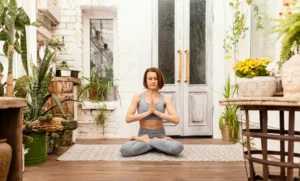We spend a lot of our time at home, so it’s important that they are comfortable, energetic, and welcoming places that help us feel good. Fortunately, there are many things you can do to improve your home’s well-being, from small changes in decoration to changes in your daily routine. In this article, we’ll give you 10 tricks to help you create a healthy and pleasant environment in your home.
1. Make cleaning a priority.
Keeping your home clean and tidy is a key part of improving your well-being. A clean home helps reduce stress and improve air quality. Here are some tips to make cleaning easier and more effective:
- Establish a regular cleaning schedule to keep your home clean and organized.
- Use natural and eco-friendly cleaning products to reduce exposure to toxic chemicals.
- To improve indoor air quality, incorporate plants into your home.
Setting a regular cleaning schedule is one of the most effective ways to keep your home clean and organized. Keeping up with all the cleaning tasks around the home can be challenging, particularly if you lead a busy life. That’s why it’s important to set a schedule that you can follow consistently.

By setting up a regular cleaning schedule, you can ensure that every area of your home is cleaned and kept tidy at all times. For example, you can dedicate one day of the week to cleaning the bathrooms and another day to cleaning the bedrooms. This way, you won’t have to worry about cleaning everything in one day, and you can keep your home clean and tidy throughout the week.
Additionally, setting up a cleaning schedule can help you be more organized and make better use of your time. Knowing what cleaning tasks you need to do and when will help you plan your day and avoid the stress of having to do everything at once.
So if you want to keep your home clean and organized, setting up a regular cleaning schedule is a beneficial way to do it. With a little planning and dedication, you can make sure your home is always in its best condition.
2. Add natural touches.


Nature can have a positive effect on our well-being, so incorporate natural elements into your home to create a calmer, more relaxing environment. Some ways to do this include:
- Add plants and flowers to your home.
- Use natural materials, such as wood and stone, in the decoration.
- Open the windows to let in natural light and fresh air.
Adding plants and flowers to your home is a wonderful way to improve the atmosphere and well-being inside. Home plants and flowers add color and beauty and improve your mood, your family’s mood, and the air quality.
Plants are known for their ability to purify indoor air as they absorb carbon dioxide and emit oxygen. This helps reduce pollution levels and improve the air quality in your home. Plants can also help reduce stress and increase feelings of well-being.
Adding plants and flowers to your home can also create a more welcoming and relaxing environment. Plants help soften a room’s hard lines and the space. You can even use plants to visually break up a large space or hide a less attractive area.
There are many plant and flower options to choose from, and you can pick the ones that best suit your tastes and needs. If you are short on space, you can opt for small plants that you can place on a table or shelf. Or, if you prefer something larger, you can opt for a large indoor plant that becomes the room’s focal point.
In short, adding plants and flowers to your home is a wonderful way to improve the environment and well-being. Whether you’re looking to purify the air, reduce stress, or simply add some color and beauty to your home, plants are a simple and effective option. Add some plants and flowers to your home today and enjoy the benefits!
3. Create a meditation space.


Meditation can be an effective way to reduce stress and improve your everyday life. Create a quiet space in your home where you can meditate and relax. Here are some tips to improve well-being and create a meditation space:
- Choose a quiet space free of distractions.
- Add comfortable pillows and blankets for seating.
- Use candles and relaxing aromas to create a calmer environment.
When it comes to creating a space for relaxation in your home, it is important to choose a quiet place free from distractions. A relaxation space should be a place where you can disconnect from the outside world and enjoy a moment of peace and quiet.
An ideal place to create a relaxation space is in a quiet room with little activity, such as a bedroom or a study. You can also choose a terrace or garden if you prefer nature.
The important thing is to choose a space that suits your personal needs and preferences. If you prefer absolute tranquility, find a space away from noise and distractions, such as a room at the end of a hallway or a quiet corner of your garden.
Also, make sure your relaxation space is free of distractions, such as televisions, computers, or cell phones. These electronic devices can interrupt your relaxation time and distract you from your goal of reducing stress and anxiety.
Finally, add elements that help you relax and create a calm environment. This can include comfortable pillows and blankets, soothing scents, soft music, or even candles. Anything that helps you feel relaxed and at peace can be a beneficial addition to your relaxation space.
In short, choosing a quiet space free of distractions is key to creating a relaxing space in your home. Find a place that suits your personal needs and preferences, and add elements that help you relax and create a calm and welcoming environment. Take advantage of your relaxation space and enjoy a moment of peace and quiet at home!
4. Make your home more welcoming.
Creating a cozy and comfortable environment in your home helps reduce stress significantly. Some ways to make your home more welcoming include:
- Use warm and soft colors in the decorations.
- Add comfortable blankets and pillows to sofas and chairs.
- Use warm, soft lighting to create a more relaxing atmosphere.
Using warm, soft colors in your decor can be an effective way to create a cozy and relaxing atmosphere in your home. Warm colors like earth tones, beiges, and pastels are key to softening the rigid lines of a room and creating a more relaxing and welcoming environment.


In addition to choosing soft and warm colors for your decor, sofa covers are an inexpensive and effective way to change the look of a room. Sofa covers are a wonderful way to change the look of a room without having to buy a new sofa.
Sofa covers are available in a wide variety of colors, prints, and fabrics, making them a versatile choice for home decor. You can opt for a sofa cover in soft, warm tones to create a relaxing and cozy atmosphere, or choose a cover in a more vibrant shade to add a pop of color and energy to the room.
Another advantage of using sofa covers is that they are simple to change and wash. If you get tired of the color or pattern of the cover, you can easily replace it with a new one. And if the cover gets dirty, you can wash it in the washing machine and use it again like new.
In short, using warm and soft colors in your decor is key to creating a relaxing and cozy atmosphere in your home. Sofa covers are a great option if you want to change the look of your home in an affordable and effective way. With a wide variety of colors, prints, and fabrics available, you can change the look of your home easily and affordably.
5. Organize your workspace.
If you work from home, it’s important to create a productive and healthy workspace. Some ways to do this include:
- Keep your workspace clean and organized.
- Use an ergonomic chair and a suitable table to avoid injuries.
- Make sure the lighting is adequate to avoid eye fatigue.
Keeping your workspace tidy is one of the best ways to boost productivity and mood at work. A tidy and clean workspace can help you focus on your tasks, reduce stress, and increase motivation.
To keep your workspace clean and organized, it’s important to have an organization system in place. This can include shelving, filing cabinets, and drawers to keep all of your paperwork and supplies organized and easily accessible.
Regular cleaning is also important to keep your workspace clean and dust-free. This can include wiping down your desk, shelves, and work surfaces. Also, make sure to keep your floors clean and free of debris.
Another way to keep your workspace clean and organized is to make sure you have enough space to work. If your desk is cluttered and full of stuff, it can be difficult to concentrate and work efficiently. Try to keep only what you need on your desk and store everything else in a file cabinet or drawer.
In short, keeping your workspace clean and organized can have a significant impact on your well-being and productivity. Make sure you have an organization system in place, clean regularly, and have enough space to work. Keep your workspace clean and tidy, and enjoy a more productive and pleasant work environment!
Must Read: 10 Electric Lawn Mowers: A Comprehensive Review
6. Create an exercise routine at home.


Regular exercise and sports activities can help you feel more energetic and healthy, as well as get a better night’s sleep. If you don’t have time to go to the gym, consider creating a workout routine at home. Here are some guidelines to get you started:
- Find a space in your home where you can exercise comfortably.
- Research workout routines online and find the one that best suits your needs and schedule.
- Purchase some basic exercise equipment, such as dumbbells or a yoga mat, to help you exercise at home.
Finding a space in your home where you can comfortably exercise can be the key to staying fit and healthy. You can exercise at home whenever you have time, making it easier to find time to go to the gym.
The first thing you need to do is find a space in your home that can serve as an exercise space. You can use an empty room, a living room, or even your garage. If you don’t have a lot of space available, consider exercising in a corner of your room.
Once you’ve found a suitable space, make sure it’s comfortable and safe. If you’re working out in an empty room, make sure the floor is clean and free of obstacles that could cause trips or falls. If you’re working out in a living room, move furniture around to make room for your workouts.
Also, make sure the space is well lit and ventilated. Good lighting can help you avoid injuries, and proper ventilation is really necessary to keep you cool during exercise.
Once you’ve set up your workout space, it’s time to find the equipment you need. If you don’t have any exercise equipment at home, consider purchasing some basic equipment, such as dumbbells, barbells, or a yoga mat. If you can’t afford to buy exercise equipment, you can look into exercise routines that don’t require accoutrements, such as squats, push-ups, and sit-ups.
In short, finding a space in your home where you can comfortably exercise can be the key to staying fit and healthy. Find a suitable space, make sure it is comfortable and safe, light and ventilate properly, and find the right exercise equipment for your needs. Start exercising at home today and enjoy a healthier, more active life!
7. Make sure you sleep well.


Sleep is important for your well-being, so make sure your bedroom is set up for restful sleep. Some ways to improve your sleep include:
- Keep the room cool and dark.
- Use comfortable, soft bedding.
- Consider using an essential oil diffuser with relaxing aromas to help you sleep better.
Keeping your bedroom cool and dark is key to enjoying quality, restful sleep. A cool, dark bedroom can help you sleep more comfortably and reduce the risk of insomnia or sleep interruptions.
First, it’s important to keep your bedroom cool. The ideal temperature for sleeping varies from person to person, but it’s recommended to keep your bedroom between 18 and 21 degrees Celsius. If your bedroom is too hot, it can be difficult to fall asleep, and if it’s too cold, you may wake up feeling cold during the night.
The darkness is another important factor. Darkness helps regulate the circadian rhythm and improve sleep quality. If there is too much light in the room, it can be difficult to fall asleep or wake up early. To keep the room dark, you can use blackout curtains or blinds to block out outside light.
Additionally, you can also consider using fans or air conditioners to keep the room cool and comfortable. Fans can help circulate the air and reduce the feeling of heat, while air conditioners can keep the room cool and comfortable all year round.
In short, keeping your bedroom cool and dark is key to enjoying quality, restful sleep. Keep the temperature between 18 and 21 degrees Celsius, use blackout curtains or blinds to block out outside light, and consider using fans or air conditioners to keep your bedroom cool and comfortable. Make sure you sleep comfortably and enjoy a restful night’s sleep!
8. Create a healthy kitchen.
Food is an important part of your well-being, so make sure your kitchen is set up to prepare healthy meals. Here are some tips for creating a healthy kitchen:
- Keep your kitchen clean and organized to make meal preparation easier.
- Invest in high-quality appliances that make meal preparation easier and healthier.
- To cook nutritious meals, stock your kitchen with fresh, healthy foods.
Must Read: 5 DIY Kitchen Countertop Ideas That Will Transform Your Space
9. Keep your electronic devices away from the bedroom.
Technology can improve our lives, but overuse can harm us. It is important to find a balance between the use of technology and taking care of our physical and mental health.
One of the ways technology can interfere with our well-being is through the excessive use of electronic devices, especially in the bedroom. Electronic devices emit blue light, which can interfere with our circadian rhythm and affect sleep quality.
To avoid the distractions that electronic devices can cause in the bedroom, try to keep them away from the space where we sleep. Try to avoid using electronic devices in bed before going to sleep, and avoid sleeping with them on in the bedroom.
Also, consider turning off electronic devices an hour before bed to help prepare your mind and body for sleep. Use that time to do relaxing activities, such as reading a book or meditating.
Another way to reduce the interference of technology with your well-being is to set time limits on your use of electronic devices. Try to reduce the amount of time you spend looking at a screen and find ways to distract yourself without technology, such as going for a walk, exercising, or talking to friends and family.
So, while technology can be useful in our daily lives, excessive use can harm our health. Try to keep your electronic devices away from the bedroom to avoid distractions and improve sleep quality. Find a balance between technology use and your physical and mental health!
10. Create a space for relaxation.
Finally, create a space for relaxation in your home. This can be a cozy living room, a quiet library, or even a relaxing bathroom. Here are some tips for creating a relaxing space in your home:
- Choose a quiet space free of distractions.
- Add comfortable pillows and blankets for seating.
- Use candles and relaxing scents to create a calmer environment.
Creating a home relaxation space can improve your physical and mental health. Daily life can be very hectic and stressful, so having a space dedicated to relaxation can be a great help in relieving stress and anxiety.


The first step to creating a relaxation space is to find a suitable place in your home. This can be an empty room, a quiet corner of your living room, or even a terrace or patio. The important thing is that it’s a place where you feel comfortable and relaxed.
Once you’ve found the right spot, start adding relaxing elements to create a cozy atmosphere. For example, you can add plants to give a feeling of freshness and nature. You can also include scented candles or essential oils to create a calm and relaxing environment.
Soft pillows and blankets to sit on and relax on are another element you can add. If you have the space, you can consider adding a comfortable chair or recliner to enjoy some downtime.
You can also incorporate relaxation routines into your space, such as meditation or yoga. There are many apps and videos online to help you practice these routines.
Make sure your relaxation space is customized to your needs and tastes. Take the time to enjoy your relaxation space and reap the physical and mental benefits.
In short, creating a relaxation space in your home can be very beneficial for your physical and mental well-being. Find a suitable location, add relaxing elements, and consider incorporating relaxation routines. Take the time to relax and enjoy your relaxation space!
Conclusion:
There are many things you can do to improve your home. From cleaning and organizing to incorporating natural elements and creating a space for relaxation, there are many ways to make your home a welcoming and healthy place. With these 10 practical tips, you can start improving your well-being today.



